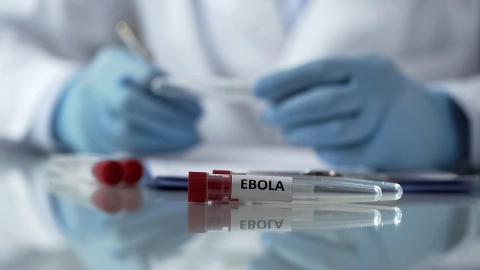Conditions Rabies
ICD codes: A82 What are ICD codes?
Rabies is a fatal viral disease transmitted by the bite of an infected animal. Germany is officially rabies-free. Anyone traveling to countries where rabies still occurs can be preventively vaccinated. All suspected cases of rabies require immediate medical treatment.
At a glance
- Rabies is a fatal viral infection transmitted to humans by the bite of an infected animal.
- The disease is no longer a concern in Germany. However, there is an increased risk of infection in regions of Asia and Africa in particular.
- Most cases of rabies are transmitted as a result of bites from stray dogs.
- All suspected cases of rabies must be treated in hospital without delay. It is important for first-aid measures to be started before symptoms appear.
- Anyone traveling to a high-risk area can be preventively vaccinated. Further vaccine doses are required following a bite from a potentially infected animal.
Note: The information in this article cannot and should not replace a medical consultation and must not be used for self-diagnosis or treatment.

What is rabies?
Rabies is a zoonotic disease, an infectious disease that can be transmitted from animals to humans.
The disease is caused by an infection with the rabies virus. Most people become infected after being bitten by an infected animal. Most cases of rabies are transmitted as a result of bites from stray dogs.
Where does rabies occur?
Rabies is common in many parts of the world. The risk of infection is increased when traveling to Africa or Asia in particular.
In most European countries, rabies has been successfully eradicated in wild and domestic animals. Germany was declared free of rabies in 2008.
However, a risk of infection cannot be ruled out if domestic animals of unknown origin are adopted from abroad.
How common is rabies?
Rabies is a notifiable infectious disease. The most recent rabies infection in Germany was registered in 2007. The case concerned an individual who had been bitten by a stray dog while on a trip to North Africa.
How many people die of rabies?
The World Health Organization (WHO) estimates that around 60,000 people die of rabies worldwide every year, but it’s likely that a large number of cases remain unreported. Most cases occur in Asia and Africa.
How is rabies transmitted?
Rabies is caused by an infection with the rabies virus. Rabies is most likely to be transmitted by stray dogs. It is also occasionally transmitted by wild animals such as bats, foxes and monkeys.
People can contract rabies if they are bitten by an infected animal and come into contact with virus particles contained in the animal’s saliva. More rarely, skin injuries or cuts and grazes may act as a point of entry for the virus if they come into contact with the animal’s saliva.
Rabies can also be transmitted through person-to-person contact. However, this is rare.
What happens in the body following infection?
Initially, the virus remains for some time at the site of the injury. Later, it travels via the nerve pathways to the central nervous system (CNS), i.e., the brain and spinal cord. There, the virus multiplies on a massive scale, leading to neurological symptoms, such as paralysis. Finally, the virus spreads through the nervous system to other organs outside of the CNS. With deep bite wounds, the virus can enter the blood directly. This provides a faster route to the brain and causes an earlier onset of symptoms.
How can rabies be prevented?
To avoid infection with the rabies virus, it is important to keep away from stray dogs and wild animals such as bats, foxes and monkeys. This reduces the risk of being bitten by a potentially infected animal.
Animals living in the wild are usually shy of people. However, they often lose their fear of people when they first contract rabies. Particular caution is needed in this case.
Is it possible to get vaccinated against rabies?
Anyone traveling to regions where rabies still occurs can get a preventive vaccine for themselves and their children. Doctors refer to this as a pre-exposure vaccine, meaning a vaccine administered before coming into contact with the pathogen. The necessity of this type of vaccine can be discussed with a doctor prior to traveling.
Recommended vaccinations
The Standing Committee on Vaccination in Germany (Ständige Impfkommission, STIKO) recommends a preventive rabies vaccine consisting of three vaccine doses. This vaccination schedule is binding for doctors in Germany.
The World Health Organization (WHO) recommends that people with a healthy immune system should receive two vaccine doses on a preventive basis. Based on this schedule, the vaccine can also be administered in Germany following a consultation.
Video How do vaccinations work?
The video below explains how a vaccination works.
This and other videos can also be found on YouTube
Watch nowThe privacy policy indicated there applies.
What should I do if I get bitten while traveling abroad?
Anyone who is bitten by an animal suspected of having rabies while traveling abroad should be seen by a doctor immediately.
The following factors are considered when assessing the likelihood of a rabies infection:
- What type of animal did the person come into contact with?
Rabies can only be transmitted by mammals. - In which country did the contact occur?
If the country is considered rabies-free, the possibility of transmission is low. - What type of contact occurred?
Touching an animal is associated with a lower risk of transmission than receiving an animal bite. - Has the person been vaccinated against rabies?
Treatment of people who have been vaccinated differs from treatment of those who have not. - What treatment has already been administered?
Further steps depend on whether vaccination or treatment has already begun.
If it is likely that a person has contracted rabies, a post-exposure vaccine should be started without delay. No time should be wasted by waiting for the rabies virus to be detected. When the vaccine is given immediately, it provides almost full protection against rabies.
Measures to treat the wound itself are also required. These include:
- Washing pathogens out of the bite or scratch wound.
- Immediately and thoroughly cleaning the wound with water and soap solution.
- Flushing deep wounds with a special probe.
- Cauterizing or suturing (stitching) of the wound.
Important: The period between contact with the virus and the appearance of symptoms of the disease may last several months. For this reason, it is still beneficial to administer a vaccine at a later stage – provided that symptoms have still not appeared. This measure may be considered if a vaccine is not immediately available locally.
What are the symptoms of rabies?
The incubation period for rabies, which is the period between contracting the virus and the appearance of symptoms of the disease, is usually between 3 and 8 weeks. In isolated cases, just a few days or several years may pass between infection and the development of symptoms.
The duration largely depends on the site of the bite on the person’s body – the closer the bite wound is to the person’s head or spinal cord, the shorter the incubation period.
Different symptoms occur during the various phases of the disease.
Phase 1: preliminary stage or prodromal stage
At the beginning, rabies is similar to a flu-like illness. Patients feel weak and exhausted. They have a headache and no appetite. Some feel sick and have to vomit. The area around the bite wound is often tender, and the person feels a burning and itching sensation at the site.
Phase 2: acute neurological stage
During this stage, the virus attacks the nerve cells in the brain or spinal cord. These cells gradually die.
Various symptoms occur, depending on which nerve cells are affected:
- Encephalitic (furious) form: this form of the disease primarily affects the brain. A typical indicator of this form is a marked fear of water. Just hearing or seeing water causes restlessness and anxiety, and even leads to spasms in the muscles used for swallowing. The spasms can spread from the muscles used for swallowing through the whole body. Because more saliva is also produced, “foaming at the mouth” occurs, where saliva flows out of the person’s mouth. The mood of a person with rabies alternates between aggressive and depressed.
- Paralytic form: this form mainly affects the spinal cord and the nerves leading to the muscles and organs. This form of rabies is marked by abnormal sensations or muscle weakness and paralysis. It can lead to difficulties with swallowing and affect the muscle used for breathing.
Phase 3: final stage
In the final phase of the disease, the part of the brain responsible for breathing and circulation fails. The patient falls into a coma and subsequently dies due to paralysis of the respiratory muscles used for breathing and the muscles in the heart. Death often occurs within just a few days of the initial onset of symptoms.
How is rabies detected?
The rabies pathogen can be detected in various ways. For example, doctors may take samples of the patient’s blood and cerebrospinal fluid (liquor). This is the fluid surrounding the brain and spinal cord. Antibodies against rabies can be detected in these samples. The antibodies are produced by the patient’s body to fight the rabies virus. However, detecting the pathogens this way is not always entirely reliable.
A more reliable method is to detect the genetic material of the rabies virus. For this purpose, a skin specimen is taken from the patient’s neck and sent for laboratory analysis.
Can rabies be treated?
If it is suspected that a person has developed rabies, they require immediate treatment in an intensive care unit.
There is currently no effective treatment for rabies. The treatment provided in an intensive care unit aims to alleviate the patient’s symptoms as far as possible. However, rabies is always fatal.
- Fooks, A.R., et al.: Current status of rabies and prospects for elimination. Lancet 2014. 384: 1389-99. doi: 10.1056/NEJMoa050382. Aufgerufen am 07.03.2023.
- Malerczyk, C., et al.: Imported human rabies cases in Europe, the United States, and Japan, 1990 to 2010. J Travel Med. 2011; 18: 402-7. doi: 10.1111/j.1708-8305.2011.00557.x. Aufgerufen am 07.03.2023.
- Robert Koch-Institut (RKI). Epidemiologisches Bulletin. 14/2022. Aufgerufen am 07.03.2023.
- Robert Koch-Institut (RKI). Epidemiologisches Bulletin. 39/2022. Aufgerufen am 07.03.2023.
- Robert-Koch-Institut (RKI). Häufig gestellte Fragen zu Tollwut und Schutzimpfung gegen Tollwut. Aufgerufen am 07.03.2023.
- Robert Koch-Institut (RKI). RKI-Ratgeber: Tollwut. Aufgerufen am 07.03.2023.
- Rothe C et al. Reiseimpfungen - Hinweise und Empfehlungen. Flug u Reisemed 2023, 30: 52-85. Aufgerufen am 08.02.2024.
Reviewed by the German Society for Tropical Medicine, Travel Medicine and Global Health (Deutsche Gesellschaft für Tropenmedizin, Reisemedizin und Globale Gesundheit, DTG).
As at:





